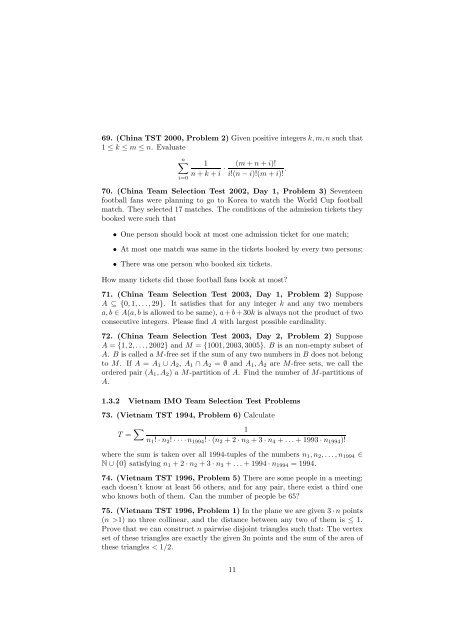Combinatorics Problems
Combinatorics Problems
Combinatorics Problems
Create successful ePaper yourself
Turn your PDF publications into a flip-book with our unique Google optimized e-Paper software.
69. (China TST 2000, Problem 2) Given positive integers k, m, n such that<br />
1 ≤ k ≤ m ≤ n. Evaluate<br />
n∑<br />
i=0<br />
1<br />
n + k + i · (m + n + i)!<br />
i!(n − i)!(m + i)! .<br />
70. (China Team Selection Test 2002, Day 1, Problem 3) Seventeen<br />
football fans were planning to go to Korea to watch the World Cup football<br />
match. They selected 17 matches. The conditions of the admission tickets they<br />
booked were such that<br />
• One person should book at most one admission ticket for one match;<br />
• At most one match was same in the tickets booked by every two persons;<br />
• There was one person who booked six tickets.<br />
How many tickets did those football fans book at most?<br />
71. (China Team Selection Test 2003, Day 1, Problem 2) Suppose<br />
A ⊆ {0, 1, . . ., 29}. It satisfies that for any integer k and any two members<br />
a, b ∈ A(a, b is allowed to be same), a+b+30k is always not the product of two<br />
consecutive integers. Please find A with largest possible cardinality.<br />
72. (China Team Selection Test 2003, Day 2, Problem 2) Suppose<br />
A = {1, 2, . . ., 2002} and M = {1001, 2003, 3005}. B is an non-empty subset of<br />
A. B is called a M-free set if the sum of any two numbers in B does not belong<br />
to M. If A = A 1 ∪ A 2 , A 1 ∩ A 2 = ∅ and A 1 , A 2 are M-free sets, we call the<br />
ordered pair (A 1 , A 2 ) a M-partition of A. Find the number of M-partitions of<br />
A.<br />
1.3.2 Vietnam IMO Team Selection Test <strong>Problems</strong><br />
73. (Vietnam TST 1994, Problem 6) Calculate<br />
T = ∑ 1<br />
n 1 ! · n 2 ! · · · ·n 1994 ! · (n 2 + 2 · n 3 + 3 · n 4 + . . . + 1993 · n 1994 )!<br />
where the sum is taken over all 1994-tuples of the numbers n 1 , n 2 , . . .,n 1994 ∈<br />
N ∪ {0} satisfying n 1 + 2 · n 2 + 3 · n 3 + . . . + 1994 · n 1994 = 1994.<br />
74. (Vietnam TST 1996, Problem 5) There are some people in a meeting;<br />
each doesn’t know at least 56 others, and for any pair, there exist a third one<br />
who knows both of them. Can the number of people be 65?<br />
75. (Vietnam TST 1996, Problem 1) In the plane we are given 3 · n points<br />
(n >1) no three collinear, and the distance between any two of them is ≤ 1.<br />
Prove that we can construct n pairwise disjoint triangles such that: The vertex<br />
set of these triangles are exactly the given 3n points and the sum of the area of<br />
these triangles < 1/2.<br />
11
















